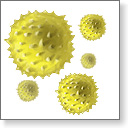| Pollen allergy |

Each spring, summer, and fall, tiny pollen grains are released from trees, weeds, and grasses. These grains hitch rides on currents of air. Although the mission of pollen is to fertilize parts of other plants, many never reach their targets. Instead, pollen enters human noses and throats, triggering a type of seasonal allergic rhinitis called pollen allergy. Many people know this as hay fever.
Of all the things that can cause an allergy, pollen is one of the most common. Many of the foods, medicines, or animals that cause allergies can be avoided to a great extent. Even insects and household dust are escapable. But short of staying indoors when the pollen count is high -- with the windows closed -- there is no easy way to avoid airborne pollen.
What is pollen?
Plants produce microscopic round or oval grains of pollen, which are used for reproduction. In some species, the plant uses the pollen from its own flowers to fertilize itself. Other types must be cross pollinated. Cross-pollination means that, for fertilization to take place and seeds to form, pollen must be transferred from the flower of one plant to that of another of the same species. Insects do this job for certain flowering plants, while other plants rely on the wind for transport.
The types of pollen that most commonly cause allergic reactions are produced by plain-looking plants (trees, grasses, and weeds) that make small, light, dry pollen grains that are spread by the wind.
Scientists have collected samples of ragweed pollen 400 miles out at sea and 2 miles high in the air. Because airborne pollen can drift for many miles, it does little good to rid an area of an offending plant. In addition, most allergenic pollen comes from plants that produce it in huge quantities. For example, a single ragweed plant can generate a million grains of pollen a day.
The type of allergens in the pollen determine whether the pollen may cause hay fever. It might seem that pine tree pollen, which is produced in large amounts by a common tree, would make it a good candidate for causing allergy. It is, however, less allergenic than other plants, and a relatively rare cause of allergy.
Among North American plants, weeds are the biggest producers of allergenic pollen. Ragweed is the major culprit, but other important sources are sagebrush, redroot pigweed, lamb's quarters, Russian thistle (tumbleweed), and English plantain. Grasses and trees, too, are important sources of allergenic pollens. Those that produce highly allergenic pollen include timothy grass, Kentucky bluegrass, Johnson grass, Bermuda grass, redtop grass, orchard grass, and sweet vernal grass. Trees that produce allergenic pollen include oak, ash, elm, birch, hickory, pecan, box elder, and mountain cedar.
It is common to hear people say that they are allergic to colorful or scented flowers like roses. In fact, only florists, gardeners, and others who have prolonged, close contact with flowers are likely to be sensitive to pollen from these plants. Most people have little contact with the large, heavy, waxy pollen grains of such flowering plants because this type of pollen is not carried by wind but by insects such as butterflies and bees.
"I love springtime, but the pollen drives me up the wall! I start taking my medication as soon as I see buds on the trees." -- Esther, age 39 |
When do plants make pollen?
One of the most obvious features of pollen allergy is its seasonal nature -- people have symptoms only when the pollen grains to which they are allergic are in the air. Each plant has a pollination period that is more or less the same from year to year. Exactly when a plant starts to pollinate seems to depend on the relative length of night and day -- and therefore on geographical location -- rather than on the weather. On the other hand, weather conditions during pollination can affect the amount of pollen produced and distributed in a specific year. Thus, in the Northern Hemisphere, the farther north you go, the later the start of the pollinating period and the later the start of the allergy season.
A pollen count, familiar to many people from local weather reports, is a measure of how much pollen is in the air. This count represents the concentration of all the pollen (or of one particular type, like ragweed) in the air in a certain area at a specific time. It is shown in grains of pollen per square meter of air collected over 24 hours. Pollen counts tend to be the highest early in the morning on warm, dry, breezy days and lowest during chilly, wet periods. Although the pollen count is an approximate measure that changes, it is useful as a general guide for when it may be wise to stay indoors and avoid contact with the pollen.
Created by the National Institutes of Health. Illustration copyright A.D.A.M., Inc.
Reviewed By: Paula J. Busse, MD, Assistant Professor of Medicine, Division of Clinical Immunology, Mount Sinai School of Medicine, New York, NY, Review provided by VeriMed Healthcare Network. Also reviewed by David Zieve, MD, MHA, Medical Director, A.D.A.M., Inc.
